Want to get up close to the work of celebrated Renaissance artist Raphael, but unsure which paintings to see or where they are? We’ve got you covered. Our guides are Raphael experts who have helped people like you discover his art on many tours. Here are Raphael’s most famous artworks and where to find them.
The 12 Most Famous Artworks By Raphael
To understand an artist’s work, we must understand their life and journey. So, before we dig into the paintings, here is a brief biography of Raphael. Raffaello Sanzio was born in Urbino in 1483. He was the son of Giovanni Santi, who was a painter and poet working for Federico da Montefeltro.
Raphael started his education as an artist with Perugino in 1495. He lived in Florence from 1504 to 1508, where he discovered the work of Michelangelo and Leonardo. Their art had a strong influence on him.
Raphael learned to blend colors by studying the works of Leonardo, according to Claudio Merlo. He also learned to draw using spiral and pyramid compositions by observing Michelangelo. In this way, Raphael became an expert in naturalism, classicism, and composition. Also, he mastered clarity of form and strokes of color.
In 1508, he settled in Rome. Nearly 10 years later, in 1517, Pope Leo X made Raphael superintendent of antiquities in Rome. In 1520, at the young age of 37, Raphael died. Today, you can still visit his tomb at the Pantheon in Rome.
With this repertoire, Raphael earned his spot as one of the three great masters of the Renaissance alongside his most inspirational artists Leonardo and Michelangelo. Finally, Raphael’s work became extremely influential for later generations of modern artists, particularly the pre-Raphaelite Brotherhood in the 19th century.
Now you know a bit more about Raphael and his life, let’s take a look at his artwork. I chose to order them chronologically, so you can see the development of his work and his artistic journey.
Not ready to book a tour? Check out our best Rome tours to take and why.
12. Madonna and Child with the Book
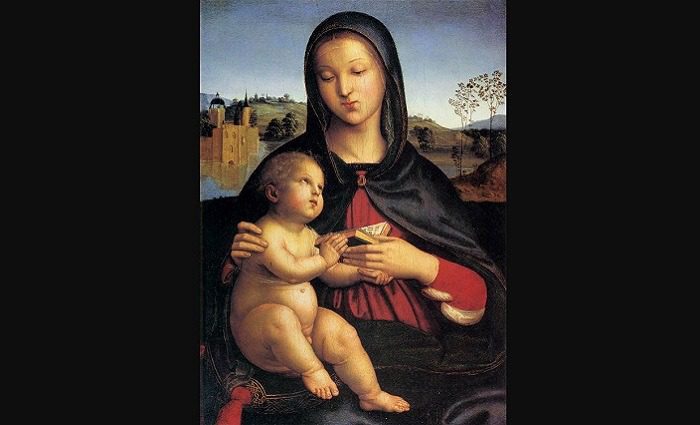

1502-1503 | Oil on Wooden Panel | Norton Simon Museum (Pasadena, California)
The Virgin Mary (Madonna) appears seated with baby Jesus on her lap and a prayer book in hand. The use of color and form is important in this painting. The Virgin’s blue mantle frames the scene and draws the viewer in. Raphael depicted the Madonna with an expression of tenderness to humanize her otherwise divine aura.
Raphael painted this when he was just 19 years old. He was finishing his training under Perugio and in the process of moving to Florence. The significance of this painting is that this would become a staple in his body of work.
Straight after this piece, Raphael would paint 17 madonnas. According to Julia Briggs, madonnas became the proverbial bread and butter work that sustained Raphael for a long time.
The Madonna was an iconic piece of Renaissance art. So, by mastering this piece, Raphael showed early on his knowledge of references and the quality of his work.
Where to see it: Norton Simon Museum, Pasadena, California
11. Madonna of the Pinks
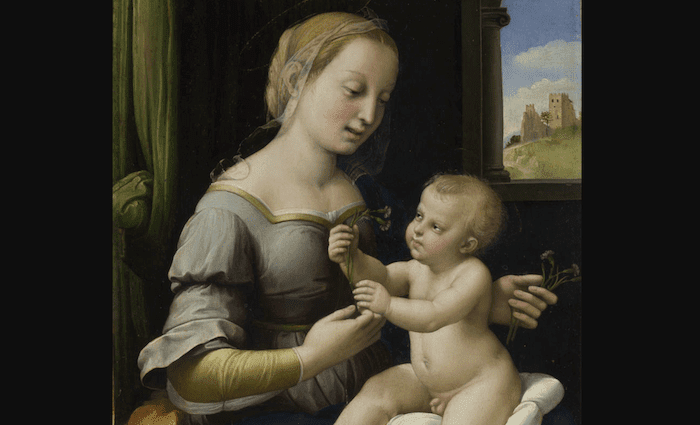

1506-1507 | Oil on Yew | The National Gallery (London)
Unlike the previous Madonna, Raphael changes the depiction of the figures by adding dynamism and more human interaction between them. In fact, it resonates with the Benois Madonna by Leonardo da Vinci.
Also, Raphael positions carnations in the center of the painting, between the Virgin Mary and Christ. This is the key topic of the painting, which is more obvious in its original name in Italian: La Madonna dei Garofani. Garofani means “carnations” in English.
The carnation holds symbolic meaning in Christian rituals. According to Jenni Davis, it reflects the divine love between the divine mother and her son. Also, it alludes to the Passion of Christ.
Roy, Spring, and Plazzotta state this painting is also significant because it uses a much simpler color palette than what is usual for Raphael. This simplicity led historians and conservationists to believe it was a copy, a fake, or the work of other artists for a long time that. However, in 1991, Renaissance expert Sir Nicholas Penny confirmed its originality.
Where to see it: National Gallery, London
10. The Deposition
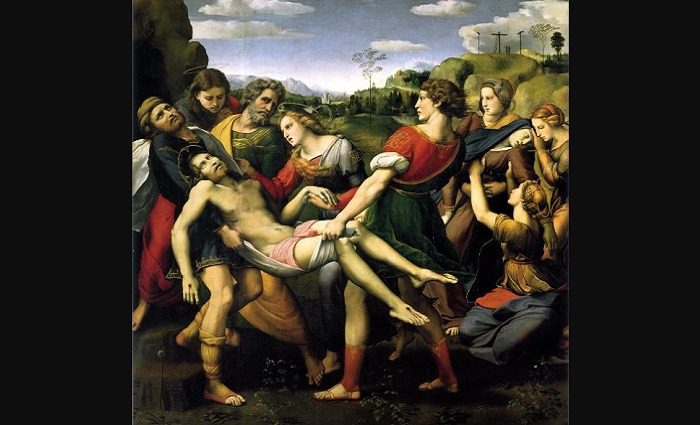

1507 | Oil on Wood | aka Pala Baglione, Borghese Entombment, or The Entombment | Galleria Borghese (Rome)
This is the central panel of a three-part altarpiece commissioned by Atalanta Baglioni of Perugia to commemorate her slain son Grifonetto.
It reminds us of the topic of Christ’s death and burial. This is a visionary painting in terms of composition and use of color. According to Frank Stella, it will be influential for the masters of tenebrism nearly a century later.
You can see the diagonal line that takes the figures and the viewer to the center of the scene, which is the dead body of Christ. Dramatic realism surrounds the scene. Also, it creates contrast with the bucolic and tender expressions of the previous Madonna.
However, if you truly want to understand this piece, you need to understand its context. Italian society was violent since the Condottiere wars of the later Middle Ages.
The Baglioni family were condottiere themselves (captains of mercenary troops). So, they lived in a dangerous environment, which ultimately caused their son’s death. The Deposition, in a way, reflects this brutal death with Jesus echoing Grifonetto.
Where to see it: Galleria Borghese, Rome
Not ready to book a tour? Find out how to visit the Borghese Gallery.
9. The School of Athens
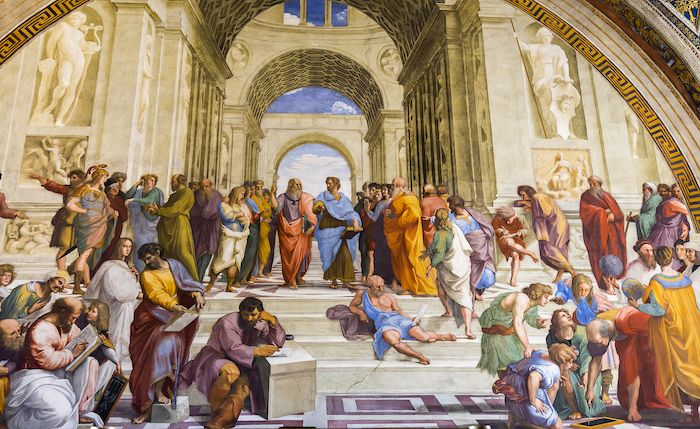

1509-1511 | Fresco | Raphael Rooms (Vatican City)
This is one of the main frescos of the Stanza della Segnatura, one of the four rooms decorated with Raphael’s work at the Vatican. The School of Athens depicts ancient and contemporary thinkers and philosophers. The central figures are Aristotle and Plato. If you look closely, you will see that Raphael depicted Plato like Leonardo Da Vinci whom he admired. Raphael also painted himself in the fresco wearing a black cap.
We know from his biography by Vasari that he did some rework after seeing Michelangelo’s Sistine Chapel, which was being painted at the same time. He changed the composition of the figures in his fresco. Apparently, Raphael found Michaelangelo inspirational (though Vasari hints that his fellow great master did not seem to appreciate the gesture).
The most remarkable aspect of this painting is the use of perspective and space to create different figures, narratives, and hierarchies. Here, Raphael addresses philosophy as the main subject, which was a key topic in the Renaissance. This fresco is also in a room that celebrates wisdom.
In the Renaissance, men were driven by logic, scientific advancements, and a deep connection with the ancient classical past. This fresco encompasses all these aspects. It’s my favorite painting by Raphael because it contains such a deep understanding of human nature.
Where to see it: Raphael Rooms in the Vatican Museums, Vatican City
8. The Parnassus
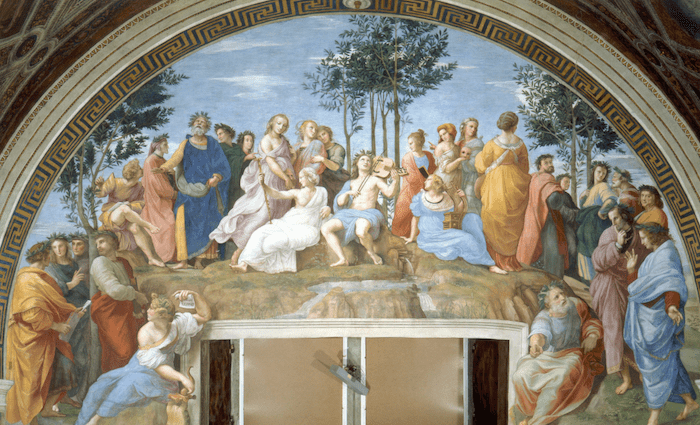

1509-1511 | Fresco | Raphael Rooms (Vatican City)
This fresco is the in the same room as The School of Athens. In fact, Raphael worked on it straight after finishing the previous fresco. The piece portrays Apollo as the god of the arts, with the nine muses, nine roman poets, and nine contemporary humanists alongside him.
Symmetry was very important in Renaissance art. Since there are nine muses, the rest of the elements in this piece had to follow suit to be equal in proportion and hierarchy.
According to Alexis R. Culotta, the lunette painting in this fresco depicts poetry because, for Raphael, this was the most important literary expression. Along with the other works in this room, The Parnassus represents the epitome of human knowledge.
Where to see it: Raphael Rooms in the Vatican Museums, Vatican City
Not ready to book a tour? Check out our best Vatican tours to take and why.
7. The Triumph of Galatea
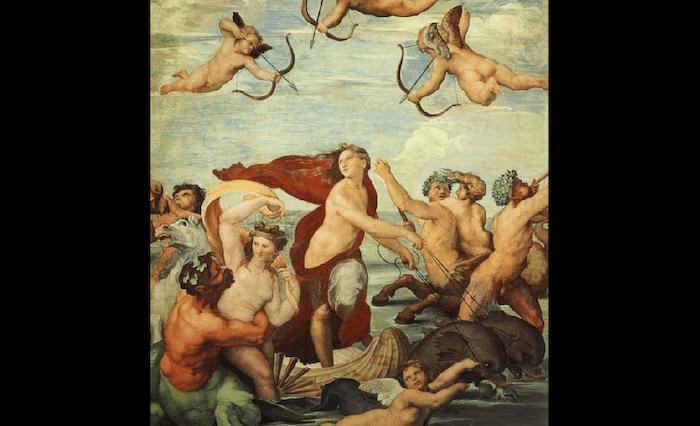

1512 | Fresco | Villa Farnesina (Rome)
This fresco depicts the Nereid Galatea from Greek mythology, triumphant in a chariot driven by dolphins. The work highlights Raphael’s best virtues as a painter. The bodies are imbued with movement through their spiral composition and the masterful use of color to define space, shape, and movement.
According to Paoletti and Radke, Galatea was Raphael’s own interpretation and borrowing of Botticelli’s The Birth of Venus. This is important because Galatea was one of the first pieces done for Agostino Chigi. Creating such a precise and fresh piece of art that still referenced recent masters would have been a great way to impress new patrons and secure future work.
Where to see it: Villa Farnesina, Rome
6. Chigi Chapel


c.1512-1516 | Architecture Design | aka Chapel of the Madonna of Loreto | Basilica de Santa Maria del Popolo (Rome)
This is the only preserved religious building where he worked as an architect. There are two sources of inspiration for Raphael’s design: St Peter’s Basilica and the Pantheon. In fact, this chapel is like a mini Pantheon for Raphael’s patron.
However, the most significant design that Raphael did for this chapel, besides the architectural work, is the decoration of the dome. It contains a beautiful mosaic of the creation of the world. Raphael, once again, brings together ancient mythology and combines it with Christian myth.
There are many more elements in this chapel that are noteworthy. However, Raphael died before its completion, and many artists after him worked on this chapel.
Patronage was a very important aspect of Raphael’s art and career. Being a patron was a sign that you were a person of wealth, style, and knowledge of trends at the time. It was a symbol of status both for the commissioner and the artist.
According to Sheryl E Reiss, Agostino Chigi was Raphael’s most important secular patron and commissioner of this chapel. Also, a great part of Raphael’s work in Rome outside of the Vatican was thanks to this wealthy banker.
Where to see it: Basilica de Santa Maria del Popolo, Rome
5. Sistine Madonna
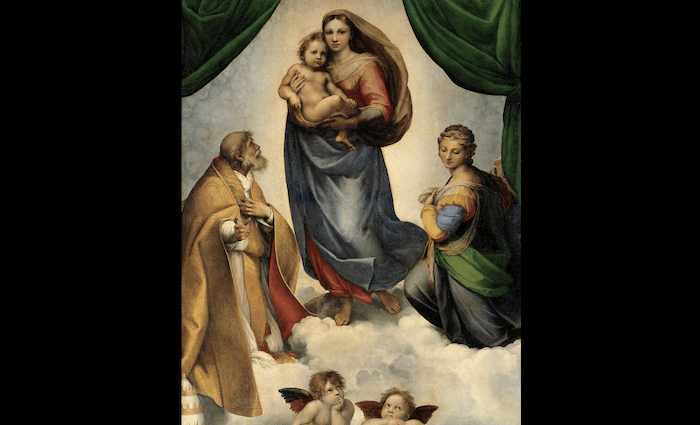

c.1513-1514 | Oil on Canvas | aka Madonna di San Sisto | Gemäldegalerie Alte Meister (Dresden)
Here, the Virgin holds Jesus, with St. Sistus and St. Barbara on either side and the putti or cherubs at the bottom. According to Julia Briggs, these putti are iconic in their own right. Also, this is one of the last Madonnas that Raphael painted.
You can see the evolution from the previous ones. For example, the color saturation demonstrates he was heavily influenced by Venetian art schools of the time and mastered this technique.
According to Kleinbub, an interpretation of this painting is that this Madonna is an apparition related to Sistus’ ascension into heaven. He points out the ethereal feel of the scene due to the clouds and movement of the robes.
In addition, the Virgin is looking directly at the viewer as if we are participants in this vision. Finally, this is one of the only two oil on canvas paintings he did. Pope Julius II commissioned the painting to commemorate his late uncle Pope Sixtus IV. Originally, it resided in the church of San Sisto (Piacenza).
Where to see it: Gemäldegalerie Alte Meister, Dresden
4. Portrait of Baldassare Castiglione
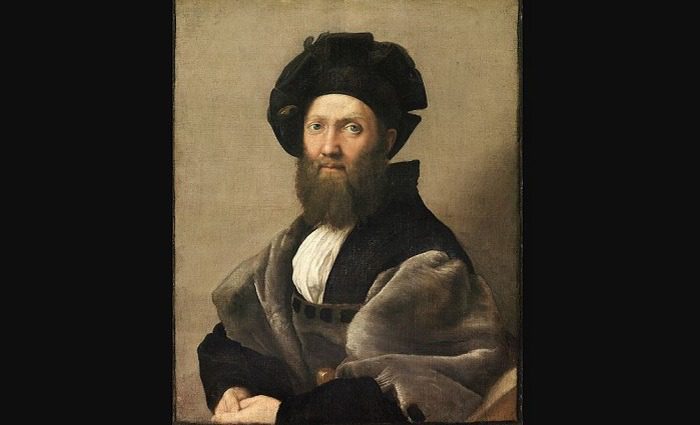

1514-1515 | Oil on Canvas | Louvre (Paris)
This portrait depicts Baldassare Castiglione, a prominent Italian courtier and author. In fact, Raphael and Baldassare were good friends. It shows the man wearing somber clothes and a kind yet restrained expression.
Although this is a far less colorful palette than what we are used to from Raphael’s other paintings, these colors speak of the person depicted—his personality and his status. Also, this is the only other oil on canvas that Raphael made.
According to Norbert Schneider, Baldassare had just written a book about the manner and sense of dress that a cultured man and courtier should cultivate. In this way, Castiglione’s portrait makes him appear elegant yet powerful, subtle yet majestic, which Raphael highlights with the soft yet well-defined curvatures of the clothing.
This is considered one of the most influential portraits in art, particularly for painting male figures. The composition and demeanor that Raphael portrays will influence the work of great artists such as Titian and Rubens.
According to Jones and Penny, this work also breaks with the pattern of other works by Raphael. The context and execution of this painting suggest this may have been a personal work done in appreciation of his friend or as a favor for Castiglione to send back home. Because of his job as a courtier, he spent a long time in Rome away from his family, whom he missed dearly, a detail that is clear in his writings.
Where to see it: Louvre, Paris
Not ready to book a tour? Find out if a Louvre Museum tour is worth it.
Not ready to book a tour? Find out if a Louvre Museum tour is worth it.
3. The Raphael Cartoons
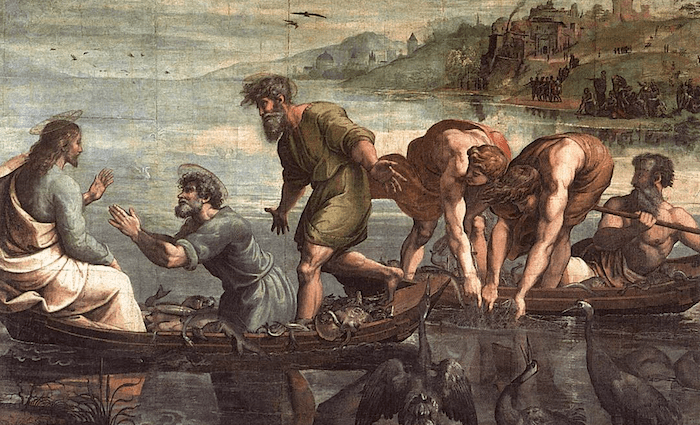

1515-1516 | Drawings | Victoria and Albert Museum (London)
The surviving cartoons (7 out of 10) are full-scale designs for tapestries commissioned by Pope Leo X to go in the Sistine Chapel. They are considered treasures of Renaissance art and a turning point in Raphael’s career.
In fact, the importance of these cartoons is apparent throughout the 18th and 19th centuries. This is because they became some of the most popular pieces of art turned into prints. Regarding the tapestries themselves, these are no longer in the chapel, but you can now see them in the Gallery of Tapestries (Vatican Museums).
According to Paul Joannides, these pieces are of much higher craftsmanship than other pieces covered in this article. This, he says, is because both Raphael and the pope saw these pieces as the highest priority on their list of works to complete. For this reason, Raphael focused to achieve the greatest results possible.
The depictions, taken from the Gospels and the Acts of the Apostles, display a heroic and austere simplicity that really set them apart from the rest of the works Raphael would produce from this moment on.
Papal Patronage
To understand these works in full, we need to understand their patron. Pope Leo X had made it his personal mission to make his mark in the Sistine Chapel, which was already full of the work and influences of other popes. So, these tapestries were crucial for his status as a pontiff. Also, Raphael had a huge challenge ahead of him.
In creating these designs, Raphael had to somehow mimic the style of the rest of the chapel. He would also have to take into consideration that the loom would produce the reverse image of his paintings. This presented an ordeal for all parties involved. But it also shows the importance of status for Renaissance popes and their patronage of masters such as Raphael.
Where to see it: Victoria and Albert Museum, London
Not ready to book a tour? Check out our best Vatican tours to take and why.
2. La Fornarina
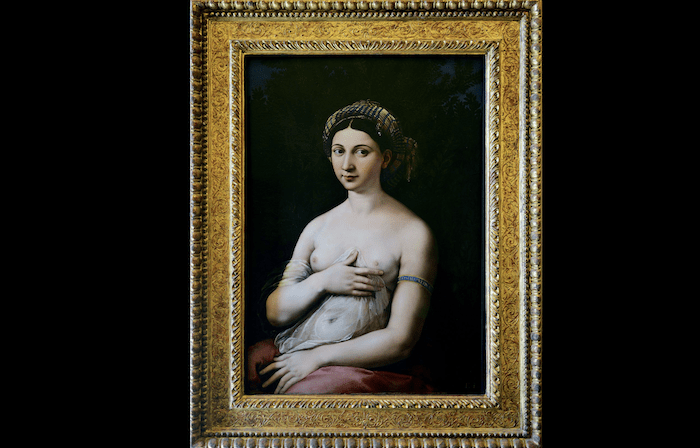

1518-1519 | Oil on Wood | aka Portrait of a Young Woman | Galleria Nazionale d’Arte Antica (Rome)
This is a painting of a young woman partially nude with a thin veil covering her abdomen. She also wears a colorful turban on her dark hair and a red skirt covering her lower body. This is a painting like no other in Raphael’s collection.
According to Jill Berk Jiminez, the artist didn’t depict anything as explicit as this semi-naked woman. The name La Fornarina (the baker’s daughter) comes from one of the interpretations regarding her identity. Jimenez proposes that the woman was Margherita Luti, daughter of a baker from Siena, who may have been Raphael’s lover.
Joanna Woods-Marsden provides an alternative reading of this portrait as a generic depiction of the Renaissance ideal of female beauty. She highlights the physical appearance of the woman.
This is similar to the Venus Pudica from ancient Greece and Rome, where Venus appears nude and attempts to cover her breasts. Other theories consider that this may be a portrait of women living on the margins of society such as witches and prostitutes.
Where to see it: Galleria Nazionale d’Arte Antica, Rome
1. The Transfiguration
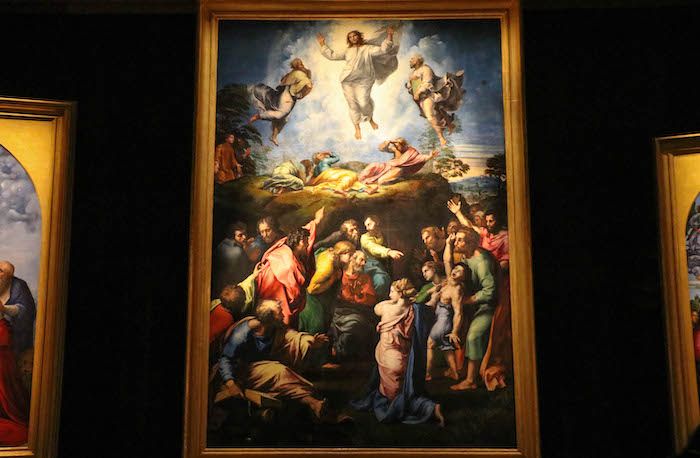

1516-1520 | Tempera Wood | Pinacoteca dei Musei Vaticani (Vatican City)
This painting shows the transfiguration of Jesus. According to Christian K. Kleinbub, this painting reflects Raphael’s internal religious dialogue and a curiosity for the actual physicality of the transfiguration miracle. Kleinbub states that the body of Christ appears to be of different sizes and proportions to the rest in the painting, which suggests a change in style, perspective, and creative process.
In fact, many art historians consider The Transfiguration a precursor for Mannerism techniques of the late 16th century, such as the stylized, contorted bodies and the baroque chiaroscuro technique.
In Christian liturgy, transfiguration is one of the miracles of Christ. It involves Christ becoming a radiant divine figure on top of a mountain where he and some of his disciples are praying. It’s also considered one of the greatest miracles because, unlike the rest, this one actually happens to him, symbolizing his divine perfection.
This, in a way, is a metamorphosis, which references Greek mythology already so beautifully incorporated by Raphael in his previous paintings. Interestingly, transfiguration is a much more popular topic for religious art in the eastern and orthodox Christian traditions than in Western Christianity.
Also, the majority of western transfiguration depictions date from the Renaissance before Raphael’s own work, which highlights the uniqueness of this painting. Finally, this painting is special because Raphael died while still working on it.
Raphael’s Final and Incomplete Work
The future Pope Clement VII commissioned the painting to be the altarpiece for Narbonne Cathedral in France. But as Raphael died and the work remained incomplete, the patron kept it.
Now that you’ve completed your journey through Raphel’s must-see masterpieces, you’re ready to see them in person! A great place to start is in Rome, specifically the Vatican. Check out our Vatican tours to see Raphael’s work up close.
Where to see it: Pinacoteca Vaticana, Vatican City
Not ready to book a tour? Find out if a Vatican tour is worth it.

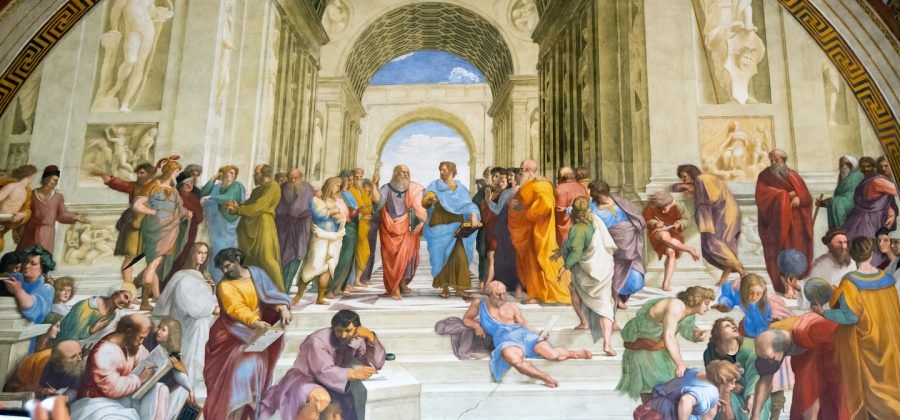
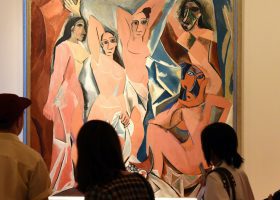
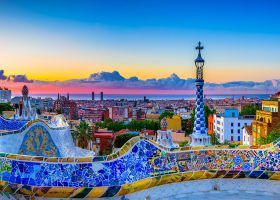
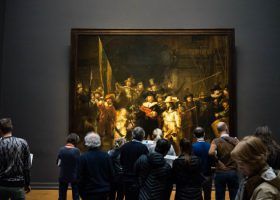
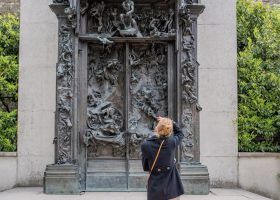
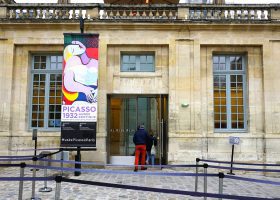
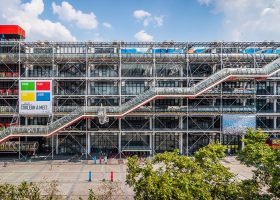


Leave a Comment